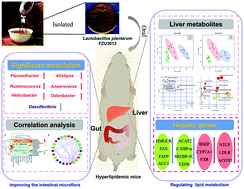The protective mechanism of Lactobacillus plantarum FZU3013 against non-alcoholic fatty liver associated with hyperlipidemia in mice fed a high-fat diet†
Abstract
Lactobacillus plantarum FZU3013, a probiotic previously isolated from the traditional brewing process of Hongqu rice wine, may have the beneficial effect of improving the disorders of lipid metabolism. This study aimed to investigate the role of L. plantarum FZU3013 in improving non-alcoholic fatty liver (NAFL) associated with hyperlipidemia in mice fed a high-fat diet. The results indicated that L. plantarum FZU3013 intervention significantly reduced the HFD-induced body weight gain and the abnormal levels of serum total triglycerides (TG), total cholesterol (TC) and low-density lipoprotein (LDL-C), and inhibited the excessive accumulation of liver lipids. In addition, L. plantarum FZU3013 also promoted the excretion of bile acids through feces. Metagenomic and multivariate statistical analysis revealed that L. plantarum FZU3013 made significant structural changes in the intestinal microbiome of the mice fed with HFD, in particular by modulating the relative abundance of some function related microbial phylotypes. Furthermore, ultra-performance liquid chromatography with quadruple-time of flight mass spectrometry (UPLC-QTOF/MS)-based liver metabolomics demonstrated that L. plantarum FZU3013 had a significant regulatory effect on the composition of liver metabolites in hyperlipidemic mice, especially on the levels of some important biomarkers involved in the pathways of glycerophospholipid metabolism, fatty acid degradation, fatty acid elongation, glycerolipid metabolism, primary bile acid biosynthesis, arachidonic acid metabolism, etc. Moreover, L. plantarum FZU3013 regulated the mRNA expression levels of the genes responsible for liver lipid and cholesterol metabolism. L. plantarum FZU3013 intervention increased the hepatic mRNA levels of cholesterol 7α-hydroxylase (CYP7A1) and the bile salt export pump (BSEP), suggesting enhanced bile acid synthesis and excretion from the liver. These findings present new evidence supporting that L. plantarum FZU3013 has the potential to improve lipid metabolism disorders through modulating specific intestinal microbial phylotypes and regulating hepatic lipid metabolism related genes, therefore it could be used as a potential functional food for the prevention of NAFL and hyperlipidemia.



 Please wait while we load your content...
Please wait while we load your content...